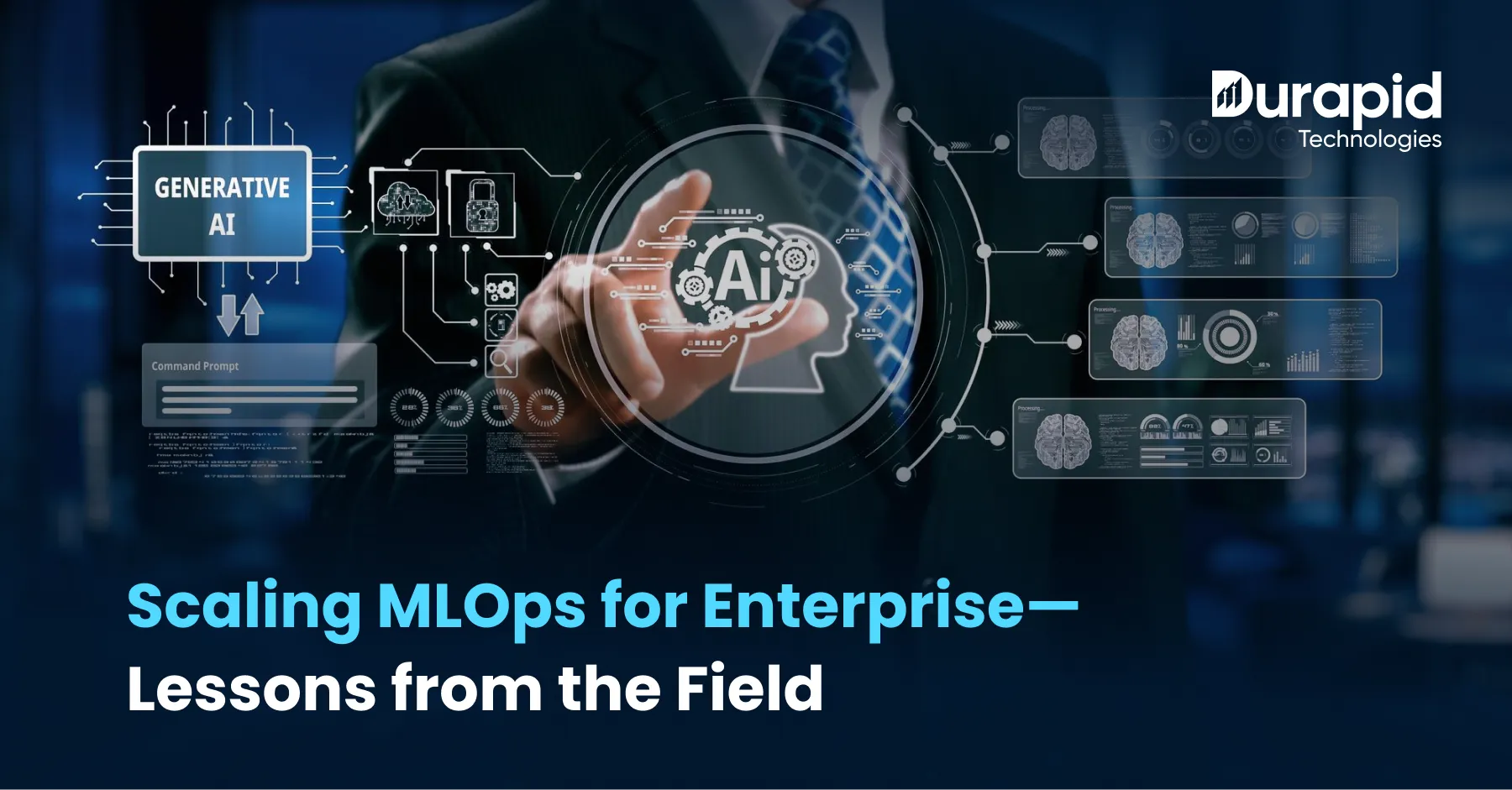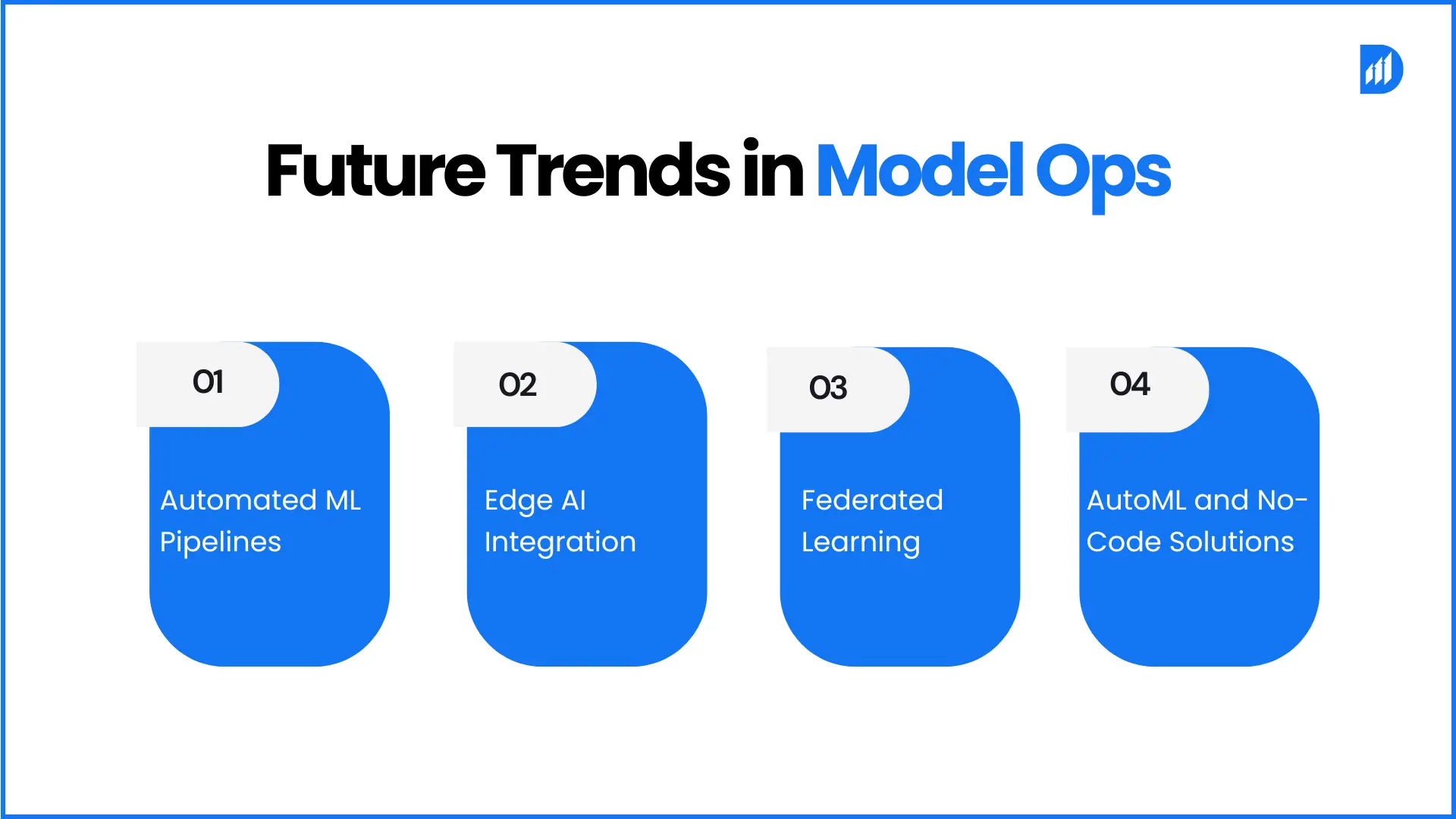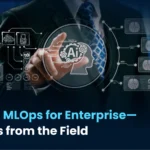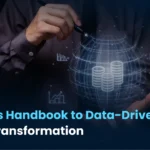Scaling MLOps for Enterprise—Lessons from the Field

Machine learning in production is where dreams go to die.
Or at least, that’s what it felt like for most enterprises until recently.
You know the story. Your data science team builds an amazing model in their notebooks. It works perfectly on their laptops. Everyone gets excited about the potential. Then you try to deploy it to production and… everything breaks.
The model that achieved 95% accuracy in the lab suddenly performs at 60% with real data. Your infrastructure can’t handle the compute requirements. Nobody knows how to monitor if the model is still working next month. And don’t even get started on compliance and governance.
At Durapid Technologies, we’ve been through this journey with 150+ clients across industries. We’ve seen the failures, learned from the mistakes, and figured out what actually works when you’re scaling ML operations for enterprise.
Here’s what we’ve learned from the field.
What is MLOps and Why Does It Matter?
Let’s cut through the jargon. MLOps isn’t just another buzzword, it’s the difference between AI projects that generate ROI and ones that drain budgets.
Think of MLOps as DevOps for machine learning. But honestly, it’s more complex than traditional software deployment because ML models are living, breathing things that change based on data patterns.
Your traditional application either works or it doesn’t. A machine learning model can silently degrade over time, giving you wrong predictions without throwing any error messages. That’s terrifying when you’re using ML for credit decisions, medical diagnoses, or supply chain optimization.
MLOps solves this by creating standardized processes for:
→ Model development and versioning
→ Automated testing and validation
→ Deployment and rollback strategies
→ Continuous monitoring and retraining
→ Governance and compliance tracking
The enterprises that nail MLOps see 3x faster time-to-market for AI solutions and 50% reduction in model failures. The ones that don’t? They’re still trying to figure out why their AI initiative hasn’t moved beyond the pilot phase.
Implementation Challenges for Enterprises
Real talk: implementing MLOps at enterprise scale is hard. It’s really hard.
The Data Pipeline Nightmare
Your data scientists work with clean, preprocessed datasets. Production systems deal with messy, real-time data streams. The gap between these two realities causes most ML projects to fail.
We worked with a financial services client where their fraud detection model worked beautifully on historical data. In production, it started flagging legitimate transactions because the live data had different formatting, missing fields, and timing issues the training data never captured.
The solution? We built data validation pipelines that catch these issues before they reach the model. Every data point gets checked for schema compliance, value ranges, and distribution shifts. It’s not glamorous work, but it prevents disasters.
Model Drift is Real (And Expensive)
Here’s something nobody tells you: your models get worse over time, even if you do nothing wrong. Customer behavior changes. Market conditions shift. New competitors emerge. Your model, trained on last year’s data, slowly becomes irrelevant.
One retail client saw their recommendation engine accuracy drop from 89% to 67% over six months. Customers were buying different products, but the model was still recommended based on pre-pandemic shopping patterns.
Now we implement continuous monitoring that tracks model performance, data drift, and business metrics in real-time. When performance drops below threshold levels, automated retraining kicks in. The client’s recommendation accuracy now stays consistently above 85%.
Infrastructure Gets Complicated Fast
Scaling ML workloads requires different infrastructure than traditional applications. You need GPU clusters for training, high-throughput inference endpoints, model registries, experiment tracking, and monitoring dashboards.
Most enterprises try to cobble together open-source tools and end up with a Frankenstein system that nobody can maintain. We’ve learned to start with cloud-native solutions that handle the complexity for you.
Our Azure ML and Databricks implementations give clients enterprise-grade MLOps without the operational overhead. You focus on the models, the platform handles the infrastructure.
Monitoring and Compliance Strategies
Monitoring ML systems is like monitoring your health—you need multiple vital signs, not just one metric.
Performance Monitoring That Actually Works
Traditional software monitoring checks if your application is running. ML monitoring needs to track if your model is making good decisions.
We track multiple layers:

→ Infrastructure metrics (latency, throughput, resource usage)
→ Data quality metrics (completeness, consistency, drift detection)
→ Model performance metrics (accuracy, precision, recall, business KPIs)
→ Prediction distribution monitoring (are outputs still reasonable?)
The key insight? Business metrics matter more than technical metrics. A model with 95% technical accuracy that reduces conversion rates by 20% is a failure, not a success.
Compliance Without Killing Innovation
Regulatory compliance for AI is getting stricter everywhere. In India, we’re seeing increased scrutiny around algorithmic decision-making in banking, healthcare, and hiring.
The traditional approach, locking down everything, kills innovation. Our approach focuses on explainable AI and audit trails without slowing down development.
We implement model lineage tracking that shows exactly what data, code, and parameters produced each prediction. Every model decision can be traced back to its inputs and business logic. When regulators ask questions, you have answers.
For one banking client, we built a governance framework that automatically generates compliance reports, flags bias in loan decisions, and maintains complete audit trails. The compliance team loves it, and data scientists can still innovate quickly.
Top MLOps Platforms
The platform landscape is evolving fast, and what works globally doesn’t always work in India.
Azure Machine Learning has been our go-to for most enterprise clients. The integration with existing Microsoft ecosystems (which most Indian enterprises use) makes adoption smoother. Pricing is transparent, and Azure’s Indian data centers ensure data residency compliance.
We’ve deployed Azure ML for clients in banking, manufacturing, and healthcare. The automated ML capabilities help smaller teams get started quickly, while advanced features support complex enterprise needs.
Databricks shines for data-heavy use cases. If your ML pipelines need to process terabytes of data, Databricks’ unified analytics platform is hard to beat. The collaborative workspace helps bridge the gap between data engineers and data scientists.
One manufacturing client uses Databricks to process IoT sensor data from 50+ factories. The platform handles data ingestion, feature engineering, model training, and deployment in one unified environment.
AWS SageMaker works well if you’re already invested in the AWS ecosystem. The managed infrastructure and built-in algorithms reduce time-to-market. However, costs can escalate quickly at scale.
Google Vertex AI offers strong AutoML capabilities and integrated MLOps features. It’s particularly effective for teams with limited ML engineering experience. The pricing model is more predictable than competitors.
For Indian enterprises, we typically recommend Azure ML or Databricks based on existing infrastructure and team skills. The learning curve is manageable, documentation is comprehensive, and support is available locally.
Future Trends in Model Ops
The MLOps landscape is moving toward more automation and standardization.

Automated ML Pipelines are becoming the norm. Instead of manually coding every step, platforms now generate end-to-end pipelines from data ingestion to model deployment. This democratizes ML for teams without deep engineering expertise.
Edge AI Integration is growing rapidly. Models trained in the cloud need to run on mobile devices, IoT sensors, and edge computing infrastructure. MLOps platforms are adding capabilities to optimize and deploy models across diverse hardware.
Federated Learning will become important for privacy-sensitive use cases. Instead of centralizing data, models learn from distributed datasets without moving sensitive information. This is particularly relevant for healthcare and financial services in India.
are lowering barriers to entry. Business analysts can now build and deploy models without writing code. However, enterprise applications still need proper MLOps governance around these citizen data scientist workflows.
The Reality of Scaling ML in Indian Enterprises
Working with 95+ Databricks-certified professionals and 150+ Microsoft-certified experts, we’ve seen patterns in how Indian enterprises approach ML scaling.
Start with Business Problems, Not Technology
The most successful MLOps implementations begin with clear business objectives. Revenue increase, cost reduction, customer satisfaction improvement, these drive platform selection and architecture decisions.
We helped a logistics company reduce delivery costs by 25% using predictive routing models. The MLOps platform choice was secondary to solving the business problem. Once value was proven, scaling became a priority.
Invest in Team Training Early
MLOps require new skills across your organization. Data scientists need to understand deployment considerations. DevOps engineers need to learn about model-specific requirements. Business stakeholders need to understand ML limitations and possibilities.
Our training programs have upskilled 300+ developers across client organizations. The investment in education pays dividends when teams can collaborate effectively on ML projects.
Plan for Hybrid Cloud Reality
Most Indian enterprises operate in hybrid environments. Legacy systems on-premises, new applications in public cloud, and data scattered across multiple locations.
Successful MLOps architectures accommodate this reality. We design solutions that work across Azure, AWS, and on-premises infrastructure, with consistent governance and monitoring.
What We’ve Learned From 150+ ML Implementations
After building 120+ web applications and scaling 35+ startups with ML capabilities, certain patterns emerge.
Simple Solutions Win
The most sophisticated ML architecture in the world doesn’t matter if your team can’t operate it. We’ve learned to start simple and add complexity only when needed.
A logistics client wanted a complex ensemble model for demand forecasting. We started with a simple regression model, established monitoring and retraining processes, then gradually added complexity. The simple model solved 80% of their problems with 20% of the effort.
Governance Enables Speed
Contrary to popular belief, good governance makes teams move faster, not slower. When you have standardized processes for model deployment, testing, and monitoring, teams stop reinventing the wheel.
Our MLOps governance templates help clients go from model development to production deployment in weeks instead of months.
Measure Business Impact, Not Just Model Accuracy
Technical metrics are important, but business metrics determine success. We’ve seen models with 95% accuracy fail because they didn’t improve business outcomes.
Now we establish business KPIs upfront and design monitoring dashboards that track revenue impact, cost savings, and customer satisfaction alongside technical performance.
The Path Forward
MLOps isn’t optional anymore. It’s the foundation that determines whether your AI investments generate returns or drain resources.
The enterprises succeeding with ML at scale have learned to treat MLOps as a core competency, not an afterthought. They invest in platforms, processes, and people simultaneously.
At Durapid Technologies, we’ve systematized this approach. Our MLOps implementations combine proven platforms (Azure ML, Databricks) with battle-tested processes and comprehensive training.
The result? Clients see 60% faster time-to-production for ML models, 40% reduction in model failures, and 3x improvement in business impact from AI initiatives.
Your competitors are already scaling ML operations. The question isn’t whether to invest in MLOps, it’s how quickly you can do it right.
The future belongs to organizations that can reliably deploy, monitor, and improve ML models at enterprise scale. The technology is ready. The platforms are mature. The only question is execution.
Frequently Asked Questions
How does MLOps improve enterprise AI success rates?
MLOps creates standardized processes for deploying, monitoring, and maintaining ML models in production. Without
Compliance requires automated audit trails, explainable AI capabilities, bias detection, and complete model lineage tracking. We implement governance frameworks that automatically generate compliance reports, flag potential issues, and maintain detailed documentation of every model decision. This enables innovation while meeting regulatory requirements.
Ready to scale your ML operations? Durapid Technologies has helped 150+ organizations successfully implement enterprise MLOps solutions. Our 95+ Databricks-certified professionals and 120+ Microsoft-certified experts can accelerate your AI transformation. Contact us at sales@durapid.com or visit www.durapid.com to discuss your MLOps strategy.





